
19 ENGLISH
NOTICE:
Never toss or drop the tool.
NOTICE:
Do not cover the vents of the tool.
Pruning trees
Bring the chain saw body into contact with the branch to
be cut before switching on. Otherwise it may cause the
guide bar to wobble, resulting in injury to operator. Saw
the wood to be cut by just moving it down by using the
weight of the chain saw.
►
Fig.23
If you cannot cut the timber right through with a single
stroke:
Apply light pressure to the handle and continue sawing
and draw the chain saw back a little.
►
Fig.24
When cutting thick branches, first make a shallow
undercut and then make the finish cut from the top.
►
Fig.25
If you try to cut off thick branches from the bottom, the
branch may close in and pinch the saw chain in the cut.
If you try to cut off thick branches from the top without a
shallow undercut, the branch may splinter.
►
Fig.26
Bucking
1.
Rest the chain saw body on the wood to be cut.
►
Fig.27
2.
With the saw chain running, saw into the wood
while using the top handle to raise the saw and the front
one to guide it.
3.
Continue the cut by applying slight pressure to the
top handle, easing the saw back slightly.
NOTICE:
When making several cuts, switch the
chain saw off between cuts.
CAUTION:
If the upper edge of the bar is used
for cutting, the chain saw may be deflected in
your direction if the chain becomes trapped. For
this reason, cut with the lower edge, so that the
saw will be deflected away from your body.
►
Fig.28
When you cut a wood under tension, cut the pressured
side (A) first. Then make the final cut from the tensioned
side (B). This prevents the bar from becoming trapped.
►
Fig.29
Limbing
CAUTION:
Limbing may only be performed by
trained persons.
A hazard is presented by the risk
of kickback.
When limbing, support the chain saw on the trunk if
possible. Do not cut with the tip of the bar, as this pres-
ents a risk of kickback.
Pay particular attention to branches under tension. Do
not cut unsupported branches from below.
Do not stand on the felled trunk when limbing.
Carrying tool
Before carrying the tool, always apply the chain brake
and remove the battery cartridge from the tool. Then
attach the guide bar cover. Also cover the battery car-
tridge with the battery cover.
►
Fig.30:
1.
Guide bar cover
2.
Battery cover
MAINTENANCE
CAUTION:
Always be sure that the tool is
switched off and the battery cartridge is removed
before attempting to perform inspection or
maintenance.
CAUTION:
Always wear gloves when perform
-
ing any inspection or maintenance.
NOTICE:
Never use gasoline, benzine, thinner,
alcohol or the like. Discoloration, deformation or
cracks may result.
To maintain product SAFETY and RELIABILITY,
repairs, any other maintenance or adjustment should
be performed by Makita Authorized or Factory Service
Centers, always using Makita replacement parts.
Sharpening the saw chain
Sharpen the saw chain when:
•
Mealy sawdust is produced when damp wood is
cut;
•
The chain penetrates the wood with difficulty, even
when heavy pressure is applied;
•
The cutting edge is obviously damaged;
•
The saw pulls to the left or right in the wood.
(caused by uneven sharpening of the saw chain or
damage to one side only)
Sharpen the saw chain frequently but a little each time.
Two or three strokes with a file are usually sufficient for
routine resharpening. When the saw chain has been
resharpened several times, have it sharpened in our
authorized service center.
Sharpening criteria:
WARNING:
An excessive distance between
the cutting edge and depth gauge increases the
risk of kickback.
►
Fig.31:
1.
Cutter length
2.
Distance between cutting
edge and depth gauge
3.
Minimum cutter
length (3 mm)
— All cutter length must be equal. Different cutter
lengths prevent the saw chain from running
smoothly and may cause the saw chain to break.
— Do not sharpen the chain when the cutter length
has reached 3 mm or shorter. The chain must be
replaced with new one.
— The chip thickness is determined by the distance
between the depth gauge (round nose) and the
cutting edge.
Summary of Contents for UC007G
Page 2: ...2 Fig 1 3 1 2 5 6 11 12 14 7 8 9 10 16 17 19 15 13 4 18 Fig 2 ...
Page 3: ...3 1 1 2 3 Fig 3 1 2 Fig 4 1 2 Fig 5 2 1 Fig 6 3 2 1 2 3 Fig 7 2 1 Fig 8 ...
Page 4: ...4 1 Fig 9 2 3 1 Fig 10 1 Fig 11 2 1 Fig 12 1 4 2 3 4 Fig 13 1 Fig 14 1 2 Fig 15 1 Fig 16 ...
Page 5: ...5 3 2 1 Fig 17 1 Fig 18 1 2 Fig 19 1 2 3 Fig 20 1 2 Fig 21 Fig 22 ...
Page 6: ...6 Fig 23 Fig 24 1 2 Fig 25 Fig 26 Fig 27 Fig 28 A B A B Fig 29 2 1 Fig 30 ...
Page 8: ...8 1 2 Fig 39 1 2 Fig 40 ...
Page 103: ...103 ...
















































